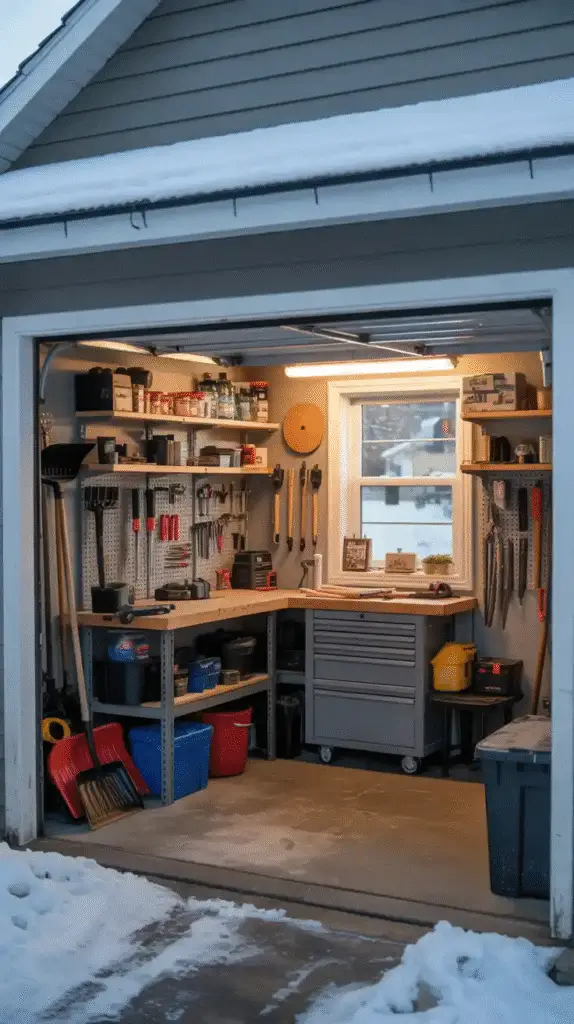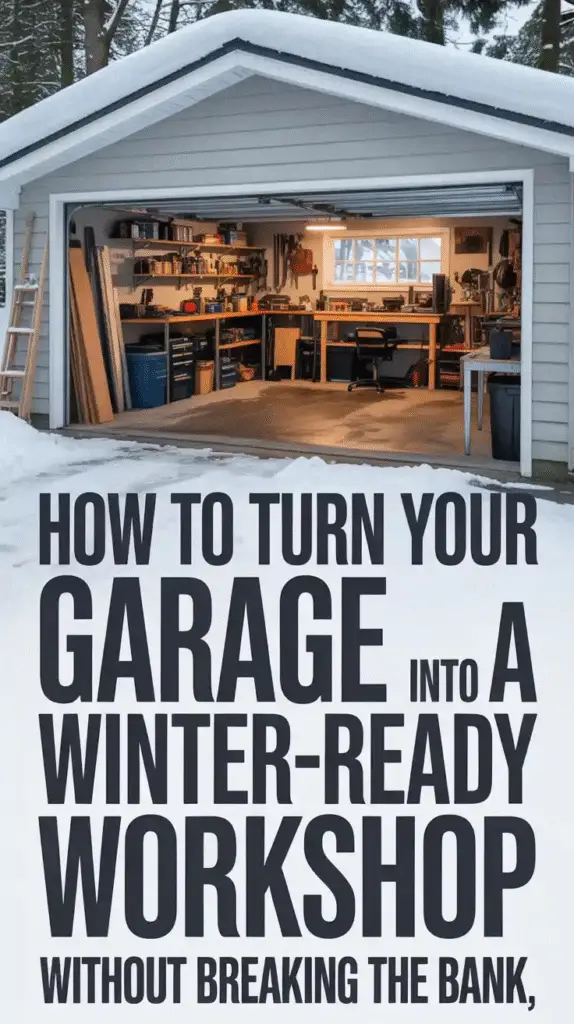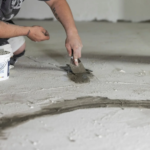The garage. For many, it’s more than a place to park the car—it’s a sanctuary. It’s the zone where creativity meets grease, where things get fixed, built, sanded, and occasionally exploded in the name of DIY. With its concrete floors, exposed studs, and utilitarian vibe, it’s the perfect mess-friendly workspace.
But when winter rolls in, this haven of productivity can feel more like a walk-in freezer. That lack of insulation, barebones structure, and zero heating? It makes your tools feel colder than your motivation. If you’re hoping to keep those projects rolling in the cold months, it’s time to reclaim your space from the icy grip of winter.

Why Garages Turn Into Iceboxes
Before you can solve the problem, you need to understand it. Most garages are built for storage, not comfort. They’re often afterthoughts—bare walls, no ceiling insulation, maybe a rickety door, and certainly no central heat. Cold air seeps in from every gap, and whatever warmth you manage to generate disappears faster than you can say “wrench.”
Premium Download
Get the Pro Garage Heating Planner & Save Money
- Help you Calculate
- Help you Plan
- Make most out of it
The three biggest culprits:
- Zero insulation: Heat escapes through walls, ceiling, and doors like air from a punctured tire.
- Poor sealing: Drafts sneak in through gaps in doors, windows, and the floor.
- Lack of heating: Without a dedicated heat source, it’s naturally going to stay frigid.
Fortunately, you don’t need to install a furnace or rebuild your garage from the studs out to make it cozy. With a bit of planning and elbow grease, you can turn that chilly cave into a functional winter workshop.

Step-by-Step Guide to Heating Your Garage the Smart Way
1. Know How Much Heat You Actually Need
Don’t just toss a heater into the corner and hope for the best. Start with a proper assessment. Too small, and it’ll never warm up. Too big, and you’re wasting electricity (and money).
Calculate Square Footage
Length × Width = Total square footage
Example: 20ft x 20ft = 400 sq. ft.

Estimate BTU Requirement
BTU (British Thermal Unit) is the standard for measuring heat output.
- Insulated Garage:
(Square footage ÷ 200) × 6000 - Uninsulated Garage:
(Square footage ÷ 200) × 9000
So, for an uninsulated 400 sq. ft. garage:400 ÷ 200 = 2 × 9000 = 18,000 BTUs
Now you know how powerful your heater needs to be.

2. Seal Every Crack and Gap
Heat loss is a silent thief. Before throwing money at a heater, lock in what you’ve got.
Start with Weatherstripping
- Apply adhesive-backed foam or rubber weatherstripping around windows and doors.
- Install door sweeps to block airflow under the garage door.
- Use caulk or expanding foam to seal any visible cracks or holes in walls.
Don’t Forget the Garage Door
This is one of the biggest heat loss points.
- Add insulation panels to the door. Kits are available and easy to install.
- Make sure the bottom seal is tight against the floor.
A well-sealed garage is the foundation for any effective heating setup.

3. Insulate Like a Pro
Insulation is the most effective long-term investment for a warm garage. It drastically reduces your heating needs, meaning you’ll save money every winter after.
Wall Insulation Options
- Fiberglass Batts: Ideal for open stud walls. Cheap and effective.
- Spray Foam: Great for sealing irregular spaces. Higher R-value but more expensive.
- Blown-In Cellulose: Works well for finished walls—just drill, fill, patch.
Ceiling Insulation
Hot air rises. Without ceiling insulation, it escapes immediately.
Use fiberglass rolls or spray foam between joists. You’ll feel the difference instantly.
Insulating the Garage Door
If you skipped this earlier, now’s the time.
Pre-cut foam boards or reflective panels are budget-friendly and boost warmth significantly.
Once insulated, your garage becomes a heat-retaining fortress. Now you’re ready to add heat without watching it vanish.
The Best Garage Heating Options for Every Budget
Once you’ve tightened up the envelope of your garage, it’s time to choose how you’ll actually warm the place up.
4. Electric Heaters: Clean, Simple, and Plug-In Friendly
Electric heaters are the go-to for many DIYers. No venting, no combustion, no fuel storage.
Types of Electric Heaters
- Plug-in Space Heaters
- Compact and portable
- Good for small, enclosed areas
- Not ideal for large garages
- Infrared Heaters
- Radiates heat like the sun
- Warms people and objects, not just the air
- Can be wall- or ceiling-mounted
- Energy efficient, quiet, and dust-free
- Split Ductless Systems (Mini-Splits)
- Provide heating and cooling
- Most efficient electric option
- Requires professional installation
- High upfront cost, low operating cost
Electric heat is low-hassle and works well if you don’t mind a slightly higher electric bill.
5. Gas Heaters: Budget-Friendly Heat with More Power
Gas heaters are ideal for large garages or those in frigid climates.
Fuel Types
- Natural Gas (connected to your home’s supply)
- Propane (from tanks)
Types of Gas Heaters
- Radiant Propane Heaters
- Cheap and effective
- Emits infrared heat like the sun
- Needs ventilation
- Keep away from flammable items
- Forced-Air Propane Heaters
- Blasts hot air through a fan
- Heats large spaces quickly
- Can stir up dust and fumes
- Louder operation
Safety tip: Any gas heater must be properly vented. And don’t skip the carbon monoxide detector—it’s a small investment that can literally save your life.

6. Wood-Burning Stoves: Rustic Charm Meets Serious Warmth
For the old-school DIYer, nothing beats the ambiance and raw heat of a wood stove.
Pros
- Low fuel cost if you have wood
- Generates powerful, radiant heat
- Doesn’t require electricity
Cons
- Needs frequent tending
- No thermostat control
- Requires chimney or vent
- May be regulated by local codes
If you have access to firewood and enjoy feeding a fire, it’s a solid long-term heat source.
Smart install: Run as much stovepipe through the interior as possible to maximize heat output.
7. Hybrid Heating Systems: Best of Both Worlds
Want flexibility? Combine systems.
- Use a small electric heater for quick warm-ups.
- Rely on a gas heater for sustained warmth.
- Supplement with infrared panels in specific zones.
This way, you’re not over-relying on one system and can tailor heat where you need it most.
8. Smart Tips for Safer, Smarter Heating
- Always keep heaters away from flammable items like rags, fuel cans, and paint.
- Install a smoke detector and carbon monoxide detector.
- Don’t run heaters unattended.
- Ventilate occasionally to keep air fresh.
- Keep an eye on humidity—warm air and concrete can create condensation.
Bonus Upgrades for a Cozier Garage
If you really want to level up, here are a few extras to enhance your comfort.
Epoxy or Rubber Floor Coating
Bare concrete gets icy. Add an epoxy coating or interlocking rubber tiles to create a warmer, safer, and more comfortable surface.
Insulated Curtains or Garage Door Blankets
Install thermal curtains or blankets along exterior walls or garage doors. They help trap heat and create a cozy feel.
Add Lighting
Winter means shorter days. Upgrade to LED lighting to make your garage bright, even on gloomy afternoons.
Workspace Zoning
Consider heating only a small corner or enclosed area where you work most often. A partitioned zone needs less energy to warm up and stays comfortable longer.
Final Thoughts: Find Your Sweet Spot
Choosing the right way to heat your garage depends on a few key factors:
- Garage size
- How often you use it
- Your climate
- Your budget
- Your comfort with installation
For small, occasional use? A plug-in heater might do the trick.
For frequent winter projects? Insulation plus a solid gas or infrared heater is your best bet.
For the homesteader-at-heart? That wood stove will keep your soul and your fingers warm.
A warm garage isn’t just about comfort—it’s about productivity. With a little effort, you can transform a cold, forgotten space into a cozy, four-season workshop.
No more frozen fingers. No more abandoning projects until spring. Just you, your tools, and a warm garage that works as hard as you do.
Ask ChatGPT

















